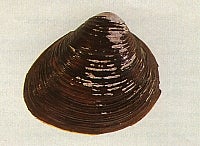Asiatic Clam or Asian Clam

Corbicula fluminea (Mueller)
Description: Shell small (less than 2 inches) round to triangular. Color is yellow in small individuals to black in larger specimens. Juveniles have a dark purple stripe on the umbo that extends ventrally. The beak is located centrally on the dorsal margin. Nacre is white to purple.
Size: Up to 2 inches. Host: Not necessary.
Comment: Introduced from Asia in the mid-1900s, the Asiatic Clam is now found throughout Alabama. Densities vary, but may reach several hundred per square meter. Abundance may be cyclic with extensive mortality events reported regularly. They can self-fertilize; and Asiatic Clams, unlike native mussels, do not use a host. Instead, Asiatic Clams have a free-living larva called a veliger. They release up to 2,000 juveniles per day, and more than 100,000 in a lifetime. Juveniles are only 1 mm long when discharged, and take one to four years to reach maturity. At this time they are about one centimeter long. Adults can reach a length of about 5 cm.
The Cyrenidae familiy was formerly known as Corbiculidae.
In Alabama, Asiatic clams may be used for bait.





